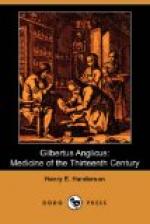Wounds of the head (f. 84 c) occur with or without fracture of the cranium, but always require careful examination and exact diagnosis. The wound is to be carefully explored with the finger, and, if necessary, should be enlarged for this purpose. Large, but simple, wounds of the scalp should be stitched with silk in three or four places, leaving the most dependent angle open for escape of the discharges, and in this opening should be inserted a tent (tuellus), to facilitate drainage. The wound is then sprinkled with the pulvis rubeus and covered with a plantain or other leaf. On the ninth to the eleventh day, if the wound seems practically healed, the stitches are to be removed and the cure completed with simple dressings.
The signs and symptoms of fracture of the cranium are: Loss of appetite and failure of digestion, insomnia, difficulty in micturition, constipation, a febrile dyscrasia, difficulty in cracking nuts or crusts of bread with the jaws, or severe pain when a string is attached to the teeth and pulled sharply. If the meninges are injured we have further: headache, a slow and irregular but increasing fever, alternating with chills, distortion of the angles of the eyes, redness of the cheeks, mental disturbances, dimness of vision, a weak voice and bleeding from the ears or the nose. In the presence of such symptoms the death of the patient may be expected within at most a hundred days.
If the fracture of the cranium is accompanied by a large scalp wound, any fragments of bone or other foreign body are to be extracted at once, unless haemorrhage or the weakness of the patient are feared, and then a piece of linen is to be cautiously worked in with a feather between the cranium and the dura mater. In the fracture itself a piece of linen, or better of silk, is inserted, the apparent purpose of this double dressing being to protect the dura mater from




